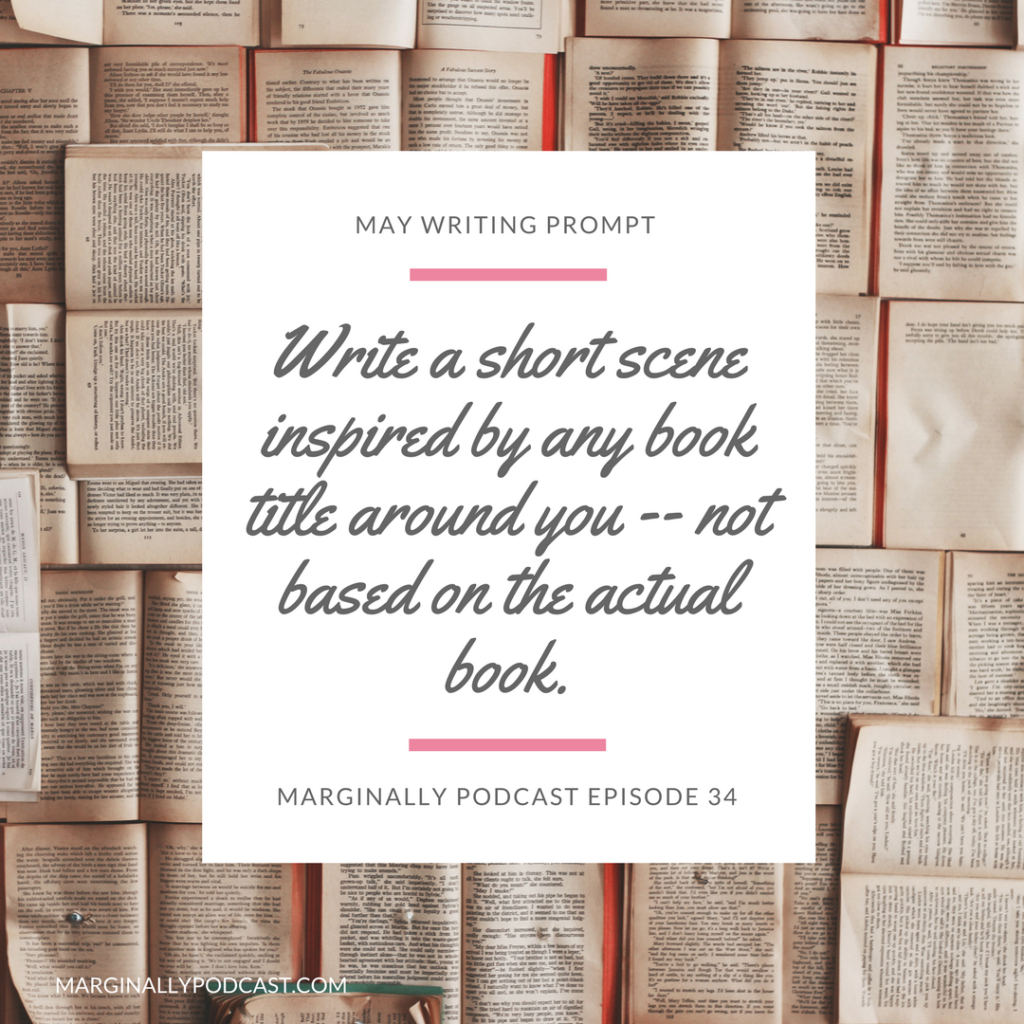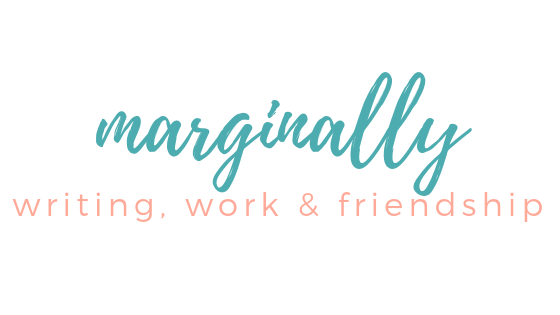This is a guest post from our Episode 14 interviewee, Divya Kohli of Yoga With Divya (London). We asked her to share a yoga sequence for creativity, and she has really come through with this one. It can be done slowly or more flow-y, but give yourself a minimum of 10 minutes – 15-20 is optimal – to get through it.
Here’s Divya’s post:
Ground, Receive, Flow, Ground:
Ready to Write!
Yoga practice can help ground restless or scattered energy, including dealing with procrastination! Postures with deeper breathing can open our physical and imaginative centres. Sequencing of certain postures will literally ignite our internal energy – including creativity – and get it to flow. Conscious engagement with our breath can set up a steadiness of mind and clearer outlook.
Here is a sequence I’ve put together to ground, open up, release and then re-ground, taking you to a place where you feel centred and ready to engage in writing flow. Ideal preparation for when you want to get creative; but also a grounding sequence for anytime you feel a need for that.
Sequence credit: Yoga with Divya
Photo credits: pictures are the original creations of illustrator and senior Yoga Teacher Bobby Clennell, apart from the last photo, taken of Divya while engaged in Alternate Nostril breathing.
Virasana (Hero) pose, with block
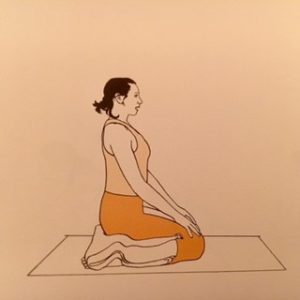
Kneel on all fours, put a block or fold a blanket and place between your heels and ankles, sit back onto the block, press the tops of your feet and toes evenly into the ground.
Now sit tall, lengthening the crown of your head upward and sense it’s poised above the tailbone. Feel even weight between both sitting bones.
Relax palms of hands up or down on the thighs.
If you feel pain or strain, add another block or raise the height under the hips to lessen tension on the back and knees. You can also place padding under the feet if there is strain there.
Ujjayi, (Victorious) Breath
After a few moments, start to connect to your breath as it is. Find it and follow it with awareness, how it’s flowing or not, wherever it’s moving to or not moving to. Spend around a minute following your breath.
Then relax.
Take a deliberate fuller breath in and then out.
Take your attention back to your breath and start to cultivate Ujjayi Pranayama (Victorious Breath), often referred to as the ‘Ocean Wave’ breath as it sounds like an ocean wave rising and falling in the distance. Channel your breath along the back of your throat (where you vocal chords are), it will feel like you are filtering the breath as you inhale and exhale through the nose, mouth stays closed. Develop a smooth, no grasping rhythm and soft ‘hushed’ sound.
Stay here for 2 to 3 minutes.
Then relax and absorb the benefits.
If your knees or back ache, stretch out the legs while you relax and absorb the benefits. Or even lie down your back with your knees bent and observe for a while.
Maryjasana & Bitilasana, Cat & Cow movement
Come onto all Fours – stretch one leg back at time, from hip to toes.
Then return to all Fours.
On an inhale, tilt the tailbone up and send the heart through the arms, allowing for the spine to concave (Cow); as you exhale, draw the third eye (forehead) and tailbone in towards each other, curving the spine upwards (Cat).
Take a few rounds, synchronising breath and movement.
Allow for any neck releasing movements, and for circling the hips if that feels releasing.
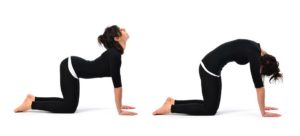
Ardho Mukha Virasana (Resting Dog)
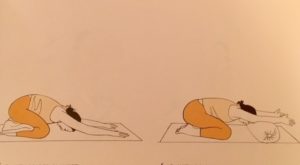
Sit back on your heels and stretch your arms out, allow the head to naturally low.
A great stretch for the whole body and particularly helpful with opening the back, regulating the kidneys (said to be ‘the seat of wellbeing’), stretching the stomach (to release tension and allow better flow of breath), and releasing tension from the hips, shoulders and head.
Stay for as long you like.
You can place head and arms on a bolster/cushion or block for added support.
Ardho Mukha Svanasana (Downward facing Dog)
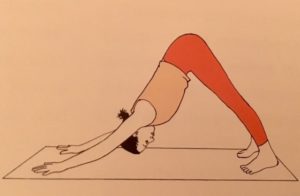
To stretch the whole body, engages every muscle and joint and helps to calm the mind.
Totally fine to have the knees bent if the legs don’t straighten, or if that helps lessen rounding in the spine, or both.
Stay for 1-2 minutes.
Stay less time if feeling stiff or tired; in which case, move in and out of the pose by moving into Child Pose when needing a breather.
Balasana (Child) Post, regroup, release the back and shoulders
Like Resting Dog pose, only place the arms by the side, reaching back, with the palms up.
Head on the mat, or supported.
Take at least one minute here, tuning into the natural flow of the breath.
Surya Namaskarasana (Sun Salutations)
A classic flow sequence, hundreds of years’ old and practised by millions every day in the world as a vehicle for waking up the body, engaging every muscle and joint, and getting our Prana (internal energy, which is a mix of our consciousness and the energy of life) to flow to every part of our body.
This version keeps things simple – not much to have to remember.
Try for 3 rounds – or up to 5 if you have the time and energy.
Alternatives:
- When lowering to the floor, feel free to lower the knees first, then the chest, then the whole body.
- When pressing up to the floor, feel free to keep the knees and hips down on the earth.
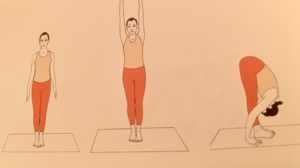
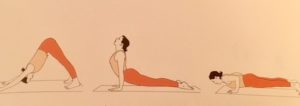

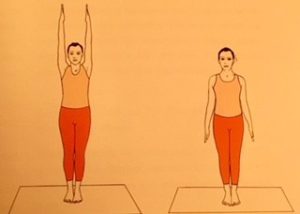
Supported Setu Bandasana (Bridge, or… Heart Over a Roll)
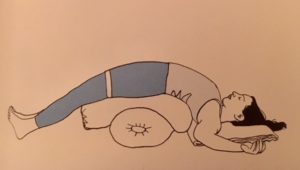
Set up a yoga bolster, and a folded blanket in front. If you don’t have a yoga bolster, or one to hand, a rolled up blanket will be perfect too. Or a couple of cushions (one on to of the other) is just fine too. If you don’t have a blanket to support the head, just ensure whatever you’re using to lean back over isn’t too high so your neck and head can relax back without strain.
Sit on the support (bolster/blanket/cushion), slowly slide the legs away, and recline back, supporting the head just before it hits the blanket or earth if not using blanket.
Let the arms fall to the side, tuck the shoulder blades down the back and send the tailbone away towards to the feet.
Settle in. Ensure there is no pain. If the lower back is not happy, bend the legs and keep the flat on the earth.
Aim for at least 3 minutes, 5 is ideal for the nervous system to chill and regulate itself. This posture and set up is also great at opening the chest, releasing fear and stagnation, and relieving stiffness from the back and hips.
Savasana (Corpse pose)
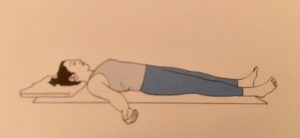
After carefully sliding out of the Supported Bridge pose, roll onto your back.
Support your head with a folded blanket or pillow if that makes your head, neck and shoulders feel more comfortable.
Let the legs roll out, arms fall out.
Settle in.
Absorb all the effects of your practice, relax and let go.
If the mind is busy or goes into planning mode, let your attention rest on the gentle unforced rise of the belly as you inhale and exhale.
Aim for 3 – 5 minutes, 5 minutes is optimal.
Whatever time available, try not to skip Savasana as it’s when you’ll absorb all the benefits of the practice. Plus it takes at least 3 minutes for your body’s muscles and joints to let go of any tension residing there. 5 minutes is optimal.
From Corpse pose, stretch, sigh, yawn, let the neck roll to one side, then the other, then slowly bring the knees into the chest, roll to your right side, and carefully press yourself up without tensing the neck.
Bring yourself into any comfortable seat.
Nadi Shodana (Alternate Nostril breathing)

If you want to prop your back against a support (back of a chair, sofa, bed or put a cushion there) that is fine. Otherwise, any comfortable seat (for example, Sukhasana, Cross legged, or Vajrasana, sitting on the heels, or even siting on a chair with an upright spine).
Take one hand up to the face, and place the index and middle finger (second and third fingers) on the bridge of the nose. Breathe in and out through both nostrils.
Breath in to and out again, and close off your right nostril with your thumb at the end of the exhale.
Breath in through the left nostril for the count of 4, then close the left nostril with your ring finger (fourth finger), release the thumb from the right nostril and exhale through the right for 4. Inhale through the right for 4, release the ring finger and exhale through the left for 4. This is one round.
Repeat.
Aim for 3 minutes.
If breathing in and out for 4 is hard to maintain, drop to 3. Or up to 5 or 6 if the breath is naturally flowing for longer and you can sustain that count without strain.
Finish up by exhaling through the left nostril.
Rest both hands on your legs or lap.
Relax.
Breath naturally through both nostrils for a few rounds.
Relax.
Sit quietly for a few moments with however you feel.
Before moving out of the practice, bow to your heart and offer gratitude to something, or someone that you feel thankful for in that moment.
Stretch out the legs, and now you’re ready for whatever you want to focus on next…
Tips:
Go at your own pace.
Use a timer on your phone or a clock.
Enjoy it, rather than striving to get deeper in the poses.
Don’t beat yourself up over how you do the postures or breathing, and try not to evaluate your practice!
If time is short, you can flow this entire sequence in as little as 10 minutes (spend less time in Savasana and on the Nadhi Shodana).
Otherwise, 15 or 20 minutes is ideal for this sequence.
Finally, do go to Yoga class – real contact with a teacher cannot be matched online.
In Peace, Divya x
